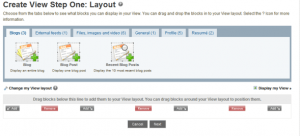Views control how you present your portfolio to the outside world. To put it another way you can decide how a user views your portfolio, by which I mean you can choose what they can see and in what order they see it.
To create a view, click “My Portfolio” and then “My Views”

Then click the “Create view” button which will bring up the screen illustrated below.

The tabbed section at the top contains what are known as “blocks”. These are configured to contain the different types of artefacts that you have placed in your portfolio. These will be discussed in detail in a future post. For now, look at the lower left of the screen where you can set your view layout.
Views are organised in columns. The default pattern is three columns, but you can have anything between one and five columns in a view. To remove a column, click the red “remove” button. To add one click one of the black “add” buttons. You can do this at any time, so if you’re halfway through creating your view and you decide you need an extra column you can choose the location of your column by clicking the appropriate “add” button.
You can also alter the layout of your columns, if you choose a 2, 3 or 4 column layout. For example, you could have a narrower left or right hand column, or a wider Centre column. Just click “Change my View layout” on the left below the blocks section and choose from the options offered
Once you’ve decided on your layout click “Next”. You’ll then be asked to give your view a name, and to write a description. You can also tag it with appropriate keywords. You’ll also be asked to specify how you would like this view to display your name.
Click the Next button again and this will take you to the final section of setting up the view, which is concerned with who you want to see it.
If you want to keep it entirely private, then just click the save button. However you have five other choices.
You can make the view entirely public. This means you will be able to give people an address, or post a link on your blog or web site and they won’t need to log in to access it.
You can make it visible to any user who happens to log in to Portfolios.lincoln
You can make it visible to any of your friends (Just as in Facebook and similar social networking sites, Portfolios.lincoln supports the creation of online friends”
You can create a “secret URL” which you can share with selected people. You might send this to employers for example so they can get a fuller view of your portfolio than you might wish to make publicly available.
Finally you can choose from a list of individual users on the site.
Whichever you choose, you can also set dates when it’s available. For example, if you are going to share your secret URL with a potential employer, you might want this to expire a few weeks after the closing date.
You must be logged in to post a comment.